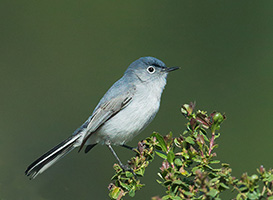 |
Blue-gray Gnatcatcher
Polioptila caerulea |
|
|
STANFORD LOCATIONS: Uncommon migrant and summer resident breeding in wooded areas near the Dish. Fairly rare elsewhere on campus. |
 |
Location |
Type |
Mating System |
Parental Care |
2ndary Diet |
Strategy |
|
|
|
|
I: 13 DAYS ALTRICIAL |
|
|
|
(To 80 feet) |
|
MONOG |
MF |
GLEAN HAWKS |
| BREEDING: | A habitat generalist: deciduous forest, woodland, swamp, srcub, chaparral, desert. 1 brood, 2 in far s. |
| DISPLAYS: | No well-marked courtship ritual. |
| NEST: | Saddled on horizontal limb or in fork; compact, of plant down and similar materials held together with insect and spider silk, covered on outside with bits of lichen, lined with fine materials. |
| EGGS: | Pale blue to bluish-white, flecked with browns, occ wreathed, rarely unmarked. 0.6" (14 mm). |
| DIET: | Includes spiders. |
| CONSERVATION: | Winters s to Bahamas, w Greater Antilles, Guatemala and Honduras. Common cowbird host. |
| NOTES: | Territorial boundaries shift as food resources change through nesting cycle. Extremely active, tail always flicking up and down or side to side. At some nests only female broods, at others task shared. |
| ESSAYS: | Decline of Eastern Songbirds; Bird Guilds; Mobbing; Territoriality; Cowbirds; Parental Care. |
| REFERENCES: | Root, 1967. |
| Help | Abbreviations | Species-Alphabetical | Species-Taxonomic | Essays-Alphabetical | |
| Except for Stanford Locations, the material in this species treatment is taken, with permission, from The Birder's Handbook (Paul Ehrlich, David Dobkin, & Darryl Wheye, Simon & Schuster, NY. 1988). | |||||